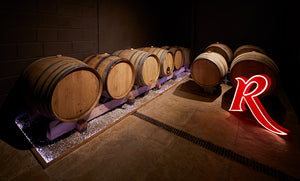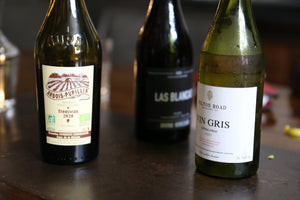This article was authored by Max Edge.

Great beer, brilliant cars, a frustratingly good international football team, lots of pork, even more sauerkraut and the somewhat unfortunate reputation for cheap sweet white wine... Some would say that’s Germany in a nutshell. However, as is often the case, there is much, much more to discover. Where better to look than two of my favourite things – food & wine.
The country’s restaurant scene is thriving, with talented and creative chefs showcasing the best in modern European cuisine. In fact, the country is ranked 4th in the world for number of Michelin starred restaurants. Clearly more than just Currywurst and Pretzels.
Where good food goes, great wine follows (or vice versa). Germany is no exception. The wine industry has changed considerably from the days of Blue Nun. The country’s winemaking trendsetters have chartered a course that’s firmly in the here and now. The sweet wines that sit at the top of the Pradikatswein tree remain amongst the world's most revered wines by aficionados and collectors alike, commanding hefty price tags at auction. Yet there is simultaneously a considerable move towards affordable and gastronomic dry wines with lower alcohol, fresh acidity and, importantly, drinkability.

Riesling has always been a popular choice for food pairings, especially with Asian cuisine. The mix of umami, spice, sweetness & acidity in the dishes requires wines with low-to-moderate alcohol levels, crisp acidity, sweetness of fruit, and/or some residual sugar. Tick, tick, tick, tick: German Riesling fits the bill.
But its not just Riesling. The food-friendly ‘Burgunder’ family of grapes are widely grown and making a name for themselves. With terroirs like those found in Alsace and Northern Burgundy, Germany’s Spatburgunders (Pinot Noir) and Grauburgunders (Pinot Gris) offer great value for money compared to their premium French cousins while pairing nicely with a wide range of cuisines.
Whenever I’m tasting wine, I immediately begin to consider the meals and recipes which would best suit. With Germany producing so much variety in their wines, the region has become fantastic inspiration and a route to trying new things in the kitchen. I also find myself returning to old favourites that have proven the perfect match to a newly discovered German wine. Here’s some recipes and suggested pairings that go far beyond the Bratwurst and Gluhwein of Christmas market fame!
Whole Steamed Seabass
with Soy, Spring Onion Dressing, and Coriander-Chili Crispy Chili Oil
- Simple to prepare (but don't tell your dinner guests). This is a real showstopper.
- The fresher the fish, the better the results!
- Steam for around 9-10 minutes and the flesh should fall right off the bone.
- Pair with Silvaner, an Alsatian varietal packed with herbal and floral notes, plus a persistent minerality coming from the limestone soils in which its grown.

Crispy Teriyaki Chicken
with Steamed Rice & Broccoli
- Making your own Teriyaki sauce is easy and stores in the fridge for weeks – no need for shop-bought. My go to is equal parts of sake, mirin & light soy sauce with a squeeze of honey, minced ginger, and a handful of sesame seeds.
- Skin on Chicken thighs with a coating of seasoned cornflour are best for a crispy coating.
- The sweet stickiness of Teriyaki can make many dry wines taste overly acidic or tart. Try something with residual sugar or sweetness of fruit with good intensity. An off-dry Riesling like a Kabinett or a Roberson favourite, Weingut Carl Koch's Riesling Trocken make great partners.
Ox Cheek Bourguignon
with Buttery Mash and Roasted Carrots
- This is one of my favourites for wintry nights. Deep, rich and flavourful sauce with tender - almost melty - beef. You can just eat this with a spoon.
- If you cannot get Ox Cheek, try with any cut of beef that is good for a low and slow cook. Short ribs or beef shin are great alternatives.
- Slow-cooked dishes are always kind to wine pairings, you can match them with fresher lighter bodied styles as well as more powerful expressions. The Weingut Carl Koch Spatburgunder or the Ebner-Ebenauer Poysdorf Pinot Noir, delightful and refreshing varietal examples.
Lemon & Herb Schnitzel
with Celeriac Remoulade
- Pork, veal, turkey or chicken are all great options.
- Add lemon zest and chopped herbs to your breadcrumbs to give the coating extra flavour.
-
Creamy, tangy & mustardy remoulade is such a easy but impressive side dish.
- Go for dry and fresh white wines with a bit of character like the lively Weingut Carl Koch Grauburgunder or the Ebner-Ebenauer Bursting Grüner Veltliner.
Barbecued Langoustines
with Asparagus & Peashoot Salad
- This is great for an alfresco late lunch in the back garden.
- Try roasting the asparagus with some flaky sea salt, olive oil and lemon zest – the tips go all crispy and savoury
- Langoustines or tiger prawns provide a sweetness against the earthy flavours of asparagus and peashoots
- Serve with a simple lemon and garlic vinaigrette.
- A Riesling would go great with this. Try the Ebner-Ebenauer Poysdorf Riesling or the Muller-Catoir Rieslaner Beerenauslese.





